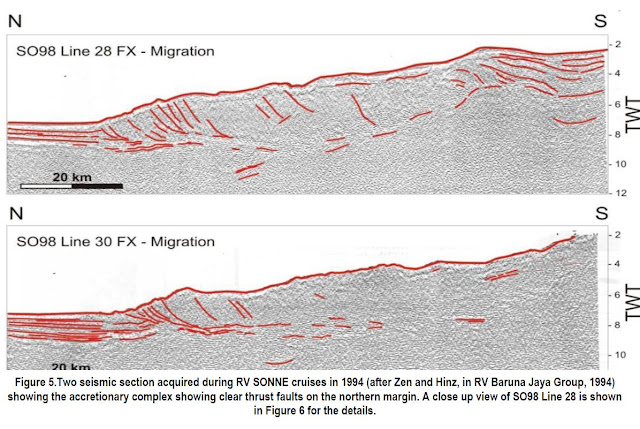 Sulawesi Sea and its surrounding area is an active tectonic region. Many studies were done to understand the tectonics in this area. For this reason, several seismic vintages were acquired in the Sulawesi Sea (Celebes Sea) area. The seismic lines were published in: 1977 by Hinz: single multichannel reflection seismic (MRS) profile 1979 by Hamilton: single trace reflection seismic lines 1987 by Hinz and 1989 by Fechner: seismic data acquired by SONNE-cruise 49 in Mindanao area, at the eastern end of the Celebes Sea Basin. 1994 by Zen and Hinz: seismic data acquired by SONNE-cruise 94, sponsored by German institutions. 1997, by Beiersdorf et al.: seismic data acquired by SONNE-cruise 98 which also did geological and geochemical investigations.
Sulawesi Sea and its surrounding area is an active tectonic region. Many studies were done to understand the tectonics in this area. For this reason, several seismic vintages were acquired in the Sulawesi Sea (Celebes Sea) area. The seismic lines were published in: 1977 by Hinz: single multichannel reflection seismic (MRS) profile 1979 by Hamilton: single trace reflection seismic lines 1987 by Hinz and 1989 by Fechner: seismic data acquired by SONNE-cruise 49 in Mindanao area, at the eastern end of the Celebes Sea Basin. 1994 by Zen and Hinz: seismic data acquired by SONNE-cruise 94, sponsored by German institutions. 1997, by Beiersdorf et al.: seismic data acquired by SONNE-cruise 98 which also did geological and geochemical investigations.
This article shows the seismic expressions in the southern margin of the Sulawesi Sea, which is the subduction zone in the north of Sulawesi North arm and known as North Sulawesi Trench (Fig. 1)
Regional Tectonics
Regional cross section in Figure 2 shows the subduction of Sulawesi Sea oceanic late to the south and goes underneath the northern arm of Sulawesi which is dominated by calc-alkalic potassic (CAK) volcanic material. This section is constructed by Walpesdorf et al. (1998) based on seismic epicenters.
 The seismicity of this area is very high and occurs in wide range of depth. Figure 3 shows the distribution of epicenters recorded by USGS. Close to the northern coast of Sulawesi, the seismicity is relatively shallow and it is getting deeper southwards. This evidence supports the regional cross section in Figure 2 is recorded by USGS in the seismicity map in Figure 3.
The seismicity of this area is very high and occurs in wide range of depth. Figure 3 shows the distribution of epicenters recorded by USGS. Close to the northern coast of Sulawesi, the seismicity is relatively shallow and it is getting deeper southwards. This evidence supports the regional cross section in Figure 2 is recorded by USGS in the seismicity map in Figure 3.
Seismic Sections
RV SONNE vessel cruises 98 acquired regional seismic sections across Sulawesi Sea Basin. One of the north-south sections displayed in Figure 4, shows general deepening of Sulawesi Sea basin to the south. The Miocene horizons clearly go beneath the thrusted zone or the accretionary complex in the north of Sulawesi.
From 2 November 1994 to 14 December 1994, RV SONNE vessel acquired seismic data in the north Sulawesi trench. The survey was chiefed by M. T. Zen (BPPT-Indonesia) and K. Hinz (Germany) who aimed to : Study the structure, the age and the geological evolution of Sulawesi Sea. Study the tectonic framework of the North Sulawesi and Mindanau continental margin which is still active. Understand the mechanism of the formation of the accretionary prism at the back zone of North Sulawesi and the west of Sangihe Island.
 Two seismic sections were published as shown in Figure 5. These condensed sections shows relatively low angle of subduction beneath a 60 km accretionary complex. Overall the system has a steep dip subduction
Two seismic sections were published as shown in Figure 5. These condensed sections shows relatively low angle of subduction beneath a 60 km accretionary complex. Overall the system has a steep dip subductionPresent day or recent tectonics activities. These evidences confirm USGS seismicity maps. Sediment supply from the onshore Sulawesi is also active. Line 28 shows an indication of recent sediment accumulation in the south of the section. Line 30 shows a steeper slope in the south of the section which may also caused by sediment supply from onshore Sulawesi.
 A detail section of line SO98-28 displayed in Figure 6 shows the oceanic crust which is overlain by Middle Miocene turbidites and Latest-Miocene to Pliocene clastic interval go beneath the accretionary complex in the south. This complex composed of intense south dipping thrust faults. The faults are getting deeper from north to south and at the same time generating more complex features.
A detail section of line SO98-28 displayed in Figure 6 shows the oceanic crust which is overlain by Middle Miocene turbidites and Latest-Miocene to Pliocene clastic interval go beneath the accretionary complex in the south. This complex composed of intense south dipping thrust faults. The faults are getting deeper from north to south and at the same time generating more complex features.
Conclusions
The studies in this area conclude that the structures are clearly shown in the front end of the accretionary zone because they are relatively young. Further south the structures are less pronounced as they have gone through more tectonic phases, the reflectors become too complex to be imaged by seismic. With limited and low data resolution, significant structure growth on seismic section which indicates fault timing is not well observed.
Some of the structures also offset the sea bottom, which indicates a relatively new fault or still on-going fault reactivation. This evidence support USGS seismicity map which show recent and active tectonic activities.



No comments:
Post a Comment